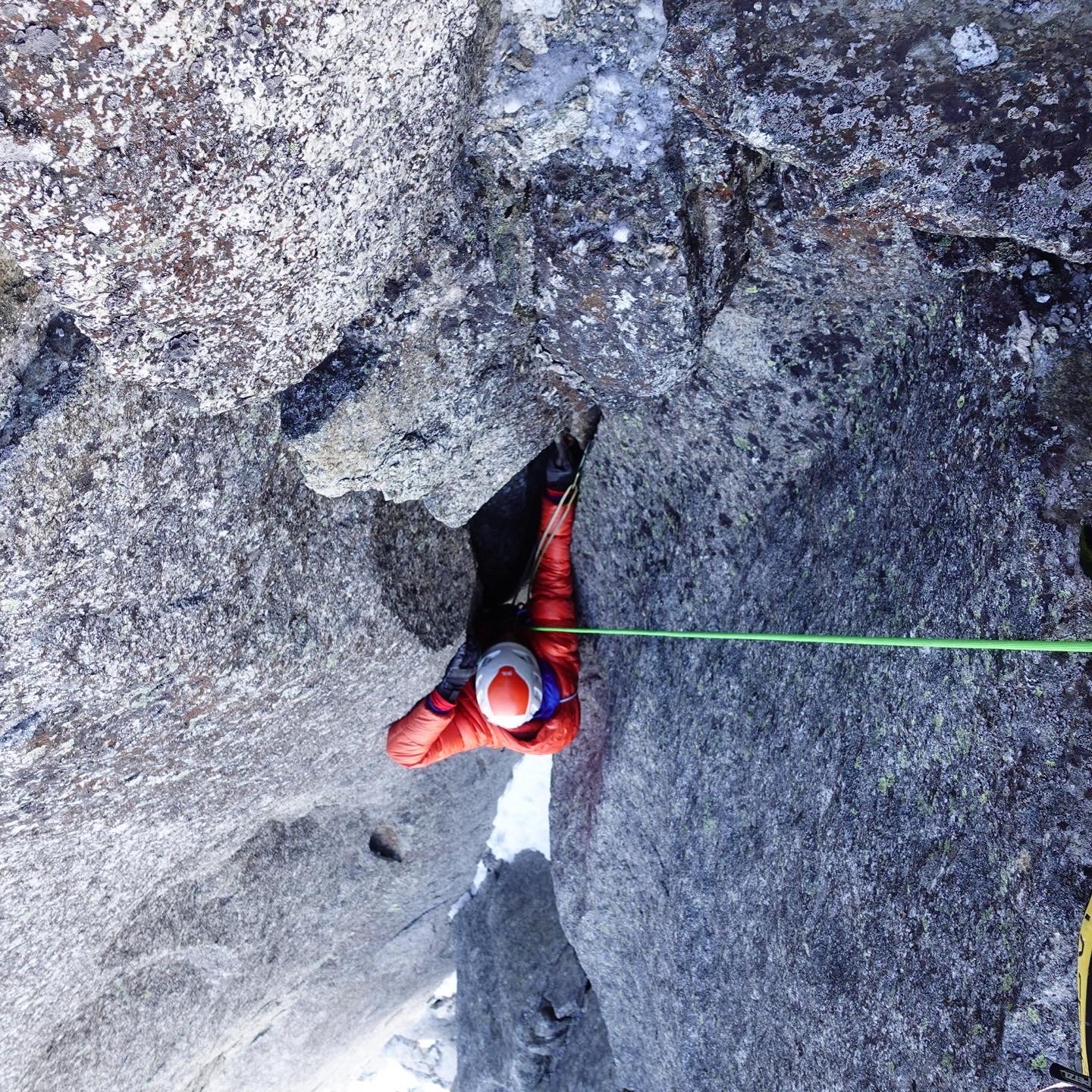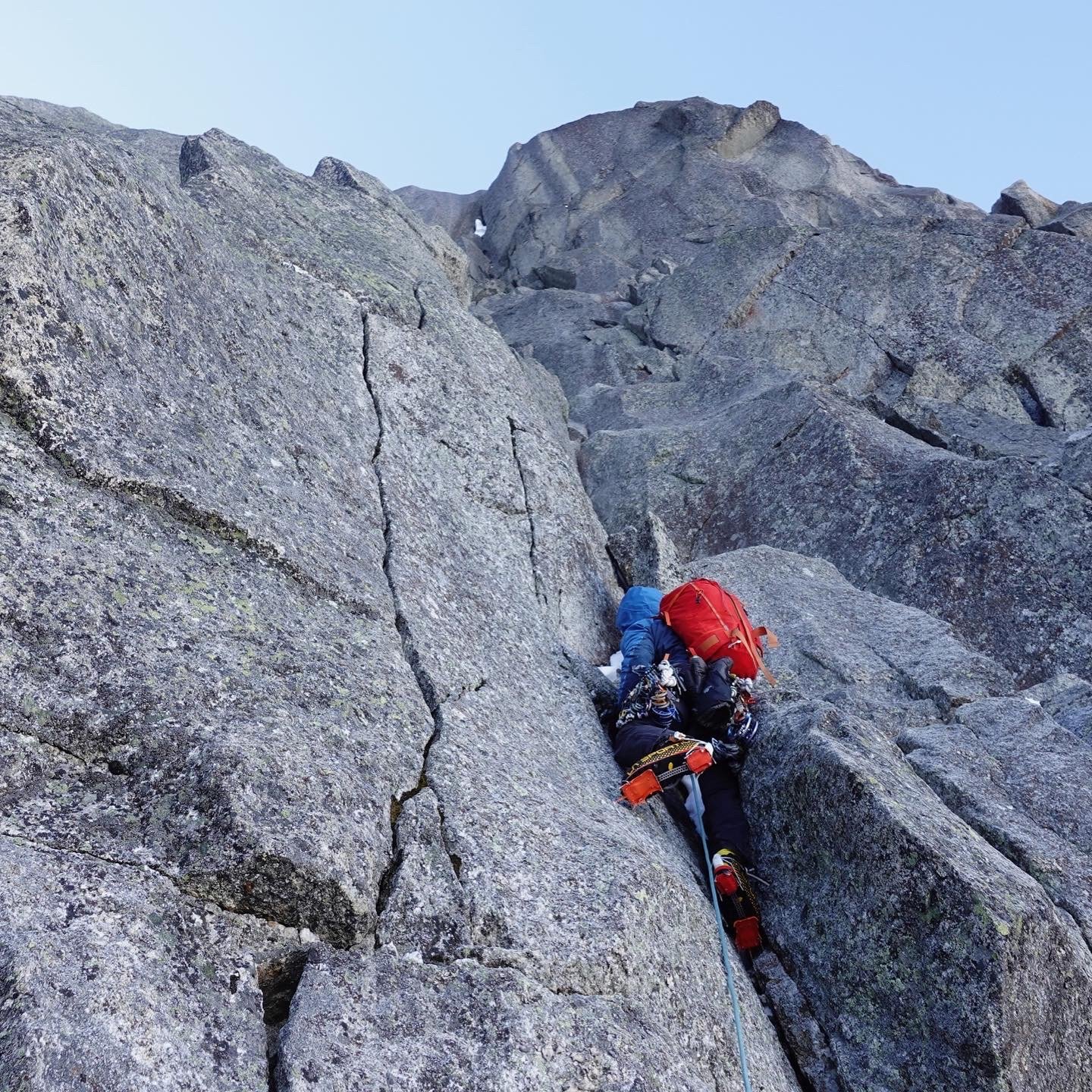Voie des Guides (Guide’s Route) - Les Drus - First Free Ascent
Over two-and-a-half days in March 2022, I made a free ascent of the Voie des Guides - an 850 metre mixed route on the north face of Les Drus, in the Mont Blanc massif. I climbed with Tom Seccombe. I think it’s one of the harder alpine routes I’ve done.
The route has been attempted by strong mixed climbers like Jeff Mercier and Korra Pesce in 2012, and the Groupe Militaire de Haute Montagne (GMHM, a dedicated group of French military alpinists). However, nobody (to my knowledge) had made a free ascent. The GMHM drew a topo and gave several pitches ‘M8+?’. Aside from these pitches, the route was quite sustained, too.
I'd noticed this route when I lived with John McCune. Every evening, we watched Les Drus from our balcony in Chamonix, mesmerised as the peaks appeared to be set on fire. We stared at the orange, gold and pink sunset colours and imagined being high on the face, often leaving our dinner to burn in the oven! The Guide’s Route apparent lack of a free ascent slightly intimidated me, since previous teams were very strong and it clearly forces a direct line through some of the steepest sections of the face. Les Drus are some of my favourite mountains: they’re amazing rocket-shaped peaks which scream out to be climbed, but also look very improbable!
I first attempted The Guide’s Route in January 2022 with Rob Smith, but throughout our bivy before the route, the tent was smashed by gusts of wind. It was a loud and shaky night, and when the alarm sounded in the morning we decided to just crag the start, since it’s not obvious where it goes. We climbed onsight up to about one-third height, reaching the base of the first M8+ pitch, before retreating with freezing bodies.
Rob Smith seconding a tricky pitch on our first attempt
The second attempt was in March with Matt Glenn, but freezing temperatures again forced us down at the end of the first day. We were often climbing in all our clothing, which made hard mixed pitches even more difficult. Nonetheless, I was happy to onsight the pitches above my previous high point, including the first M8+ pitch. It follows an overhanging crack which gets thinner and thinner, with fewer footholds. High steps onto granite crystals between shallow pick placements led me to the belay. We bailed after this point, and I learned if the temperatures are forecast to be -21 degrees C at night… they probably will be!
Returning a few days later with Tom Seccombe and warmer temperatures, we climbed to the Dru’s famous ‘Niche’ on the north face on 10th March. Again, I freed all pitches and marvelled at the steep terrain as I hauled the packs. Tom and I passed several good bivy sites to reach the Niche, believing there’d be a better place higher up, but were then dismayed to find only a poor snow ledge to sleep on.
On the second day we forged up the left side of the Niche, our tired arms and minds beginning to slow. Where previous teams had walked up the Niche, we climbed bare slabs of rock and scratched at scraps of nevé; it’s a shame to think this iconic feature may completely disappear in another few years. Tom S. led up a loose corner, then I climbed an enjoyable and steep dry-tooling crack. I’m glad I occasionally visit the Rive Gauche dry-tooling/mixed crag - it’s good preparation for this type of climbing! I still clung to the free ascent as we inched higher. We swung lead blocks, but snow flurries began to cloud the mountain as we spotted the crucial - and famous - traverse along the Quartz Vein. Apparently, our good weather was coming to an end. Tom S. took the lead and I didn’t object.
Of course, I wanted to free every pitch, but on an alpine route it would be a far greater challenge than normal (and quite selfish) to want to lead every pitch. This isn’t El Capitan, where both team members can take turns to lead every single pitch - and have several redpoints if necessary. I don’t think it’s practical or logical to define a ‘free alpine ascent’ by saying you have to lead every single pitch; nor is it logical. I certainly wanted to lead all the crux and harder pitches, and felt I did this.
Tom made a pendulum along the Quartz Vein and then I teetered across, finding good hooks and footholds. Since I’d freed this pitch and good weather returned, I decided to go ‘full attack’ and give all my energy to freeing the rest of the route. I launched up the second ‘M8+?’ pitch, described on the topo as ‘*** mythical corner.’ The dihedral ended with a two-metre roof. Shaking out beneath it, I placed as much gear as I could, filled my lungs, then launched into the roof, pulling the lip. Power screams helped my axes stay in baggy torques, and I had the full exposure of the Drus dropping below me. I was pretty pumped when I reached the belay!
I led one more thin M7 pitch as night fell, then found a ledge for us to sleep on. We jumped into the tent and crashed out. Waking up to several centimetres of fresh snow, we were initially very worried: suddenly, conditions were like Scotland, where Tom and I had just been climbing with the UK’s Young Alpinist Group! We’d also run out of proper food, since we didn’t expect (or want) to bivy a second time on the mountain. We had hot electrolyte water and a few Werther’s Originals (boiled sweets) for breakfast.
Tom S. climbed two final M6+ pitches whilst sweeping away the snow and I freed them on second, psyched that the climbing pitches were over. Around noon, we reached the summit, hungry but content, then rapped down the Dru’s North Couloir. In situ anchors made the 14 rappels pass quickly, but the Direct pitches looked very unappealing and I wouldn’t recommend them right now.
I felt very satisfied to have freed the route (although I don’t mind if it’s the FFA or the 10th Free Ascent). My research hasn’t found a record of a free ascent, and I’m just very happy to have realised a long-term project: this was something I’d wanted to do for a few months. It’s a shame the weather wasn’t conducive to climbing to the summit during my first and second attempts, but that’s a) alpinism, where sometimes it works and sometimes it doesn’t, and b) my fault for being too optimistic when reading the forecast!
I also thought this ascent was good preparation for an upcoming expedition, where running out of food, pushing on with tired arms and minds, and ‘trying something unlikely’ are possibilities. Tom S. and I had a great adventure which was certainly challenging and involved a lot of modern, difficult climbing.
I don’t know about the grades of the pitches, but I’d say it’s one of the harder alpine routes I’ve done. Somewhere between M7+ and M8+ seems about right. (I agree with Raphael Slawinski, who’s a famously ‘harsh but fair’ grader and says ‘M7+ is really hard, and a big grade in the mountains.’ I’d rather be a bit of a sandbagger than a giveaway grader, and agree that onsight trad M7+ in the mountains can be difficult, so would lean towards this grade for Voie des Guides.
Rob Smith on Day 1, attempt 1
Me climbing the first M8+ pitch on day 1. Attempt 2. Photo: Matt Glenn
Me climbing the M7 pitch just before the pitches leading to the Niche. Attempt 2. Photo: Matt Glenn
Tom Seccombe climbing the big corner above the niche. Day 2, attempt 3.
Me climbing the twin cracks M6 pitch, just above the first M8+ pitch. Attempt 2. Photo: Matt Glenn
Tom Seccombe climbing on Day 1, Attempt 3.
Me climbing the second M8+ pitch, Day 2, Attempt 3. Photo: Tom Seccombe
Me climbing the Quartz Vein pitch, Day 2, Attempt 3. Photo: Tom Seccombe
Me climbing one of the final tricky pitches, Day 3, Attempt 3. Photo: Tom Seccombe
Tom Seccombe climbing one of the final tricky pitches, Day 3, Attempt 3.
Cumbre!










